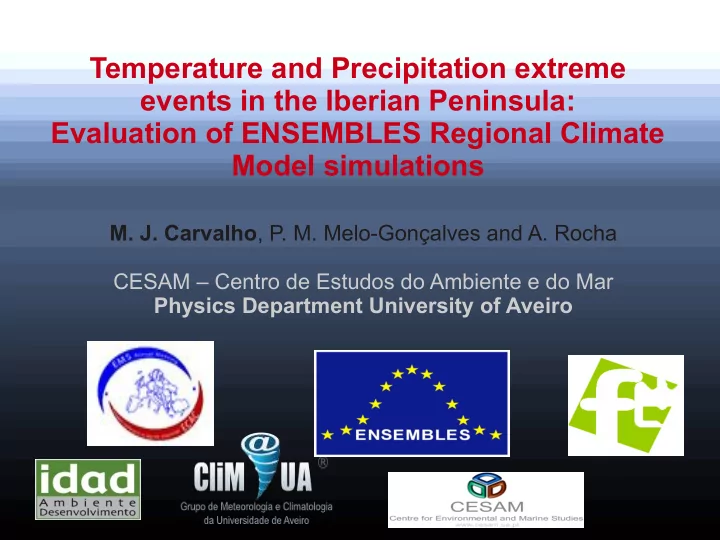

Temperature and Precipitation extreme events in the Iberian Peninsula: Evaluation of ENSEMBLES Regional Climate Model simulations M. J. Carvalho , P. M. Melo-Gonçalves and A. Rocha CESAM – Centro de Estudos do Ambiente e do Mar Physics Department University of Aveiro
From the ENSEMBLES Project to CLIPE CLIPE is a FEDER and FCT funded project which aims to study climate change of extreme episodes in the Iberian Peninsula and its forcing mechanisms. http://climetua.fis.ua.pt/climetua/projects ENSEMBLES Integration area CLIPE Study area Topography of the domain - GTOPO database. Resolution of 0.22º x 0.22º
Objective ● There are several ongoing parallel works. This particular one is focused on the reliability and uncertainty associated with climate simulations, specifically, in the ENSEMBLES simulations. ● Here, only the ensemble of the simulations will be discussed, not focusing on any particular model.
Which datasets were used? Combination of forcing GCM and RCM forced used for this work. Note that there are more simulations in the ENSEMBLES project. European Climate Assessment and Dataset (ECAD) E-OBS dataset (with a 0.22º x 0.22º resolution in a rotated grid)
How to evaluate performance? ● ETCCDI and other extreme event definitions for both daily temperature and precipitation Precipitation Min. Temp. Max. Temp. Mean Temp. PRCPTOT TN10p TX90p TG10p CDD Mean Cli. Mean Cli. TG90p CWD FD CWFI R95p HWFI ETR R95pTOT
How to evaluate performance? ● ERA40-driven ensemble and GCM-driven ensemble (median) of the indexes were compared to E-OBS indexes: – Spatial average of climatologies and uncertainties of the ensembles; – Spatial differences between ensembles and observed climatologies of the indexes; – Study of the time variability of the indexes; – Testing the similarity of the observed and modelled time distributions of the indexes;
Climatologies ● For each index, the ERA40-driven ensemble meand and the GCM-driven ensemble mean were calculated. ● The spatial mean of their summer and winter climatologies was determined, using the data for the entire Iberian Peninsula domain. ● The spread of each of the ensembles was also determined to assess their overall variability
Results PRCPTOT R95p TN10p Tmin Climatology TX90p Tmax Climatology TG10p TG90p
Climatology diff. fields ● Represented difference fields to examine geographical variations in ensemble performance. ● Differences only represented where their difference is statistically significant at the 95% confidence level and where the spread of the ensembles is lower than 25%
R95p Winter - DJF Summer - JJA OBS ERA40-OBS OBS ERA40-OBS GCM-OBS GCM-ERA40 GCM-OBS GCM-ERA40 ● GCM-OBS larger than ERA40-OBS, as expected; ● But low(ish) differences between ERA40 and GCM driven ensembles; ● JJA lower differences than for DJF (JJA = dry season!) ● Higher diff. DJF in SE Iberia, where lower diff. In JJA
TX90p Winter - DJF Summer - JJA OBS ERA40-OBS OBS ERA40-OBS GCM-OBS GCM-ERA40 GCM-OBS GCM-ERA40 ● Significant differences in the northern part of the W coast and along the Pyrenees between ERA40-OBS and ensembles in DJF; ● W Coastline large diff. Between ERA40 and OBS opposite sign but larger between ensembles in the central to eastern part of the Iberia.
TG90p Winter - DJF Summer - JJA OBS ERA40-OBS OBS ERA40-OBS GCM-OBS GCM-ERA40 GCM-OBS GCM-ERA40 ● NW area shows larger positive diff. between ERA40/GCM and OBS for both seasons; ● JJA shows large negative differences in the SE of the Iberia (which, means that the GCM-drinven enseble is underestimating the index); ● Negative diff. along the west-coast of the Iberia.
Testing the PDF's ● For every grid point, the Probability Distribution Function of the ensembles was tested against the observed one, as well as between ensembles. ● The Kolmogorov-Smirnov Test was used and the p-value field represented for summer and winter
Testing the PDF's TX90p Winter - DJF ERA vs OBS GCM vs ERA GCM vs OBS Summer - JJA ERA vs OBS GCM vs ERA GCM vs OBS
Testing the PDF's TG90p Winter - DJF ERA vs OBS GCM vs ERA GCM vs OBS Summer - JJA ERA vs OBS GCM vs ERA GCM vs OBS
Time variability ● To assess time variability, the time series of the winter and summer spatial mean indexes was represented, together with the observed variability (shaded). ● This was done after applying an 11-year running mean to remove decadal variability.
Time variability R95p Winter - DJF Summer - JJA TX90p Winter - DJF Summer - JJA
Time variability TG10p Winter - DJF Summer - JJA TG90p Winter - DJF Summer - JJA
Concluding remarks ● GCM-driven and ERA40-driven ensembles show better performance for temperature indexes than for precipitation ones; ● High spatial variability in performance, with lower one near coastlines and in areas of more complex topography; ● Climatologies show better performance than percentile-related indexes; ● Higher level statistical analysis shows lower performance than simpler ones (e.g.: climatologies).
Further work... ● Using these results to separate the Iberian Peninsula into regions and evaluating performance in those regions seperately; ● Analysing climate change projections using ETTCDI indexes (and other tools), keeping in mind the results from this analysis ● ...
Acknowledgments This study was supported by FEDER funds through the Programa Operacional Factores de Competitividade – COMPETE and by Portuguese national funds through FCT – Fundação para a Ciência e a Tecnologia , within the framework of Project CLIPE PTDC/ AAC- CLI/111733/2009.
Recommend
More recommend